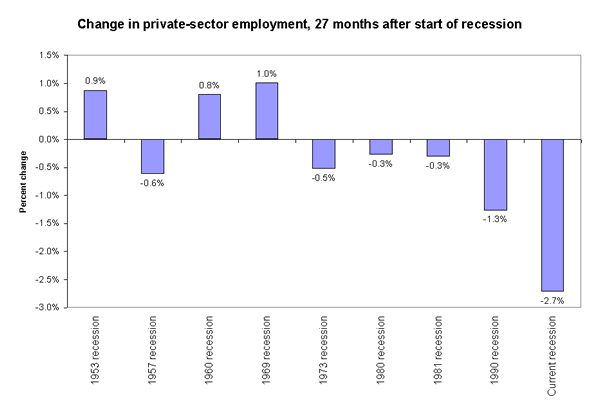June 6, 2003
Jobless recovery persists as unemployment continues to climb
Unemployment rose to 6.1% last month according to today’s report from the Bureau of Labor Statistics (BLS). This is the highest level reached thus far in the current weak recovery, and the highest level since July of 1994. Payroll employment fell slightly, by 17,000, with larger losses in government and manufacturing. The share of the population employed is historically low, and long-term unemployment remains stuck at recessionary levels, suggesting that the jobless recovery is persisting.
Extensive revisions in today’s BLS report also show that the nation’s job deficit is deeper than was previously recognized. These revisions to the payroll data led to some significant changes in recent job trends. Over the longer term, the jobless recovery has been considerably more costly in terms of job loss than shown in earlier data. Most recently, however, job loss has been milder than previously reported.
Prior to the revisions, it appeared that 2.1 million total jobs and 2.7 million private-sector jobs were lost between the beginning of the recession in March 2001 and April of this year. With today’s revisions, and including May’s results, those losses have been revised to 2.5 million and 3.0 million. Both in terms of numbers and percentages, more private-sector jobs have been lost over this downturn than in any prior comparable period in post-WWII history (see figure below).

Most recently, however, the revised data show that the pace of job loss has slowed. Pre-revised data showed payrolls down by 525,000 between January and April of this year; revisions reduced this loss to 272,000.
This month’s revisions have no impact on the household survey used to derive unemployment and employment rates. Just under 9 million persons were seeking work last month, an increase of 3.4 million since unemployment hit its low point in late 2000. While the rate for most groups was unchanged, significant increases occurred for adult men-up 0.3 percentage points to 5.9%-and Hispanics. Note that while the overall unemployment rate is up 2.2 points from its low of 3.9% in October of 2000, Hispanic unemployment, at 8.2%, is up 3.1 points, and black unemployment is up 3.4 points.
Employment rates-the share of a given group with jobs-are also indicative of how weak the labor market is for some groups of workers. The employment rate for men, 68.7% is the lowest it has been since May 1983, when the unemployment rate was 10.1%, suggesting that the current 6.1% unemployment rate is not fully capturing the lack of job opportunities for these workers. Similarly, the employment rate for college graduates-75.4%-is the second-lowest rate in the history of this series, which begins in January of 1992 (the lowest rate was 75.2% last July), evidence of weakness among white-collar workers.
Other indicators of weak job creation include long-term unemployment and the share of the unemployed as a result of layoffs. The share of the unemployed who were job losers rose from 54.2% to 56.5%, the highest level since October 1992. The average spell of unemployment fell slightly from 19.6 weeks to 19.2 weeks, but this indicator remains near the peaks of earlier, and much deeper, recessions.
Manufacturing employment declined by 53,000, its 34th consecutive month of job loss. If anything, factory job losses have accelerated lately, suggesting that the falling dollar is not yet reversing job hemorrhaging in this industry. The level of manufacturing employment stands at its lowest since October 1958.
Retail trade employment fell slightly last month, by 14,000, and is down 358,000 over the recession, suggesting recent reports of increased sales by retailers are not yet showing up in hiring. A new sector, information, fell slightly last month but is down 417,000 since the recession began. Within this sector, since the onset of the recession in March 2001, large employment losses have occurred in Internet publishing (down 17,500), telecom (-187,000), and Internet service providers (-83,000). Government employment, a source of growth earlier in the downturn, has begun to feel the brunt of budget cuts. Public-sector employment is down 68,000 since this February, with 23,100–one-third of the loss–in local government education.
This is another in a series of weak reports on labor market conditions. While revisions show fewer payroll losses thus far this year, the slow-growth economy has left us with a gaping jobs deficit, far larger than in any post-war recovery by this stage of the business cycle. It will take many quarters of consecutive fast growth to repair the damage.
—Jared Bernstein
with research assistance by Brendan Hill
The Economic Policy Institute JOBS PICTURE is published each month upon release of the Bureau of Labor Statistics’ employment report.
